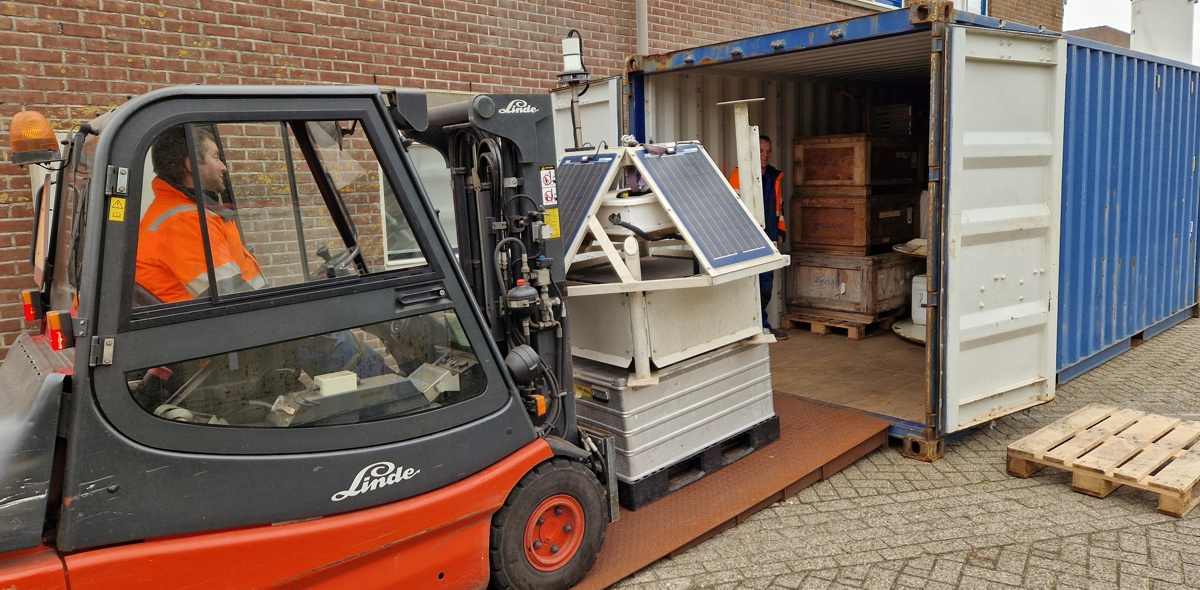RV Pelagia expedition 64PE540 departed from Mindelo on Sao Vicente (Cabo Verde) on Tuesday 28 January 2025 and has arrived at Las Palmas on Gran Canaria (Spain) on Wednesday 19 February: the expedition has ended successfully. Thanks for following this blog!
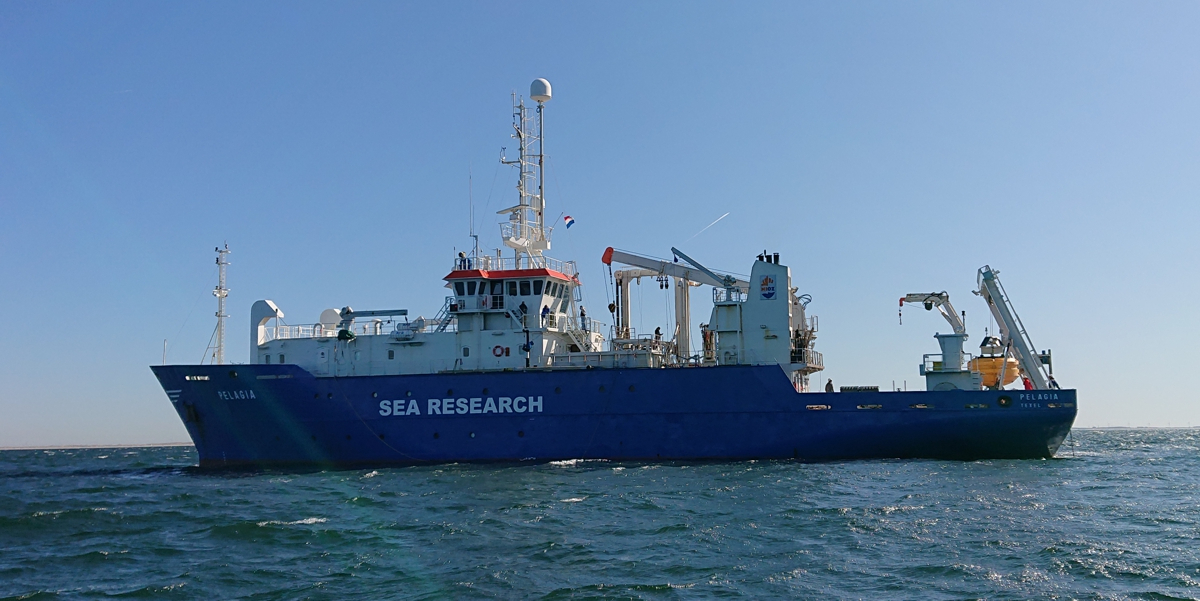
Below this line, we have posted regular updates, the most recent at the top.
18 and 19 February - The End of a TIP-TOP Expedition
That’s it, that’s all. After an eventful expedition we made it back to Las Palmas. We sincerely thank everyone who contributed to its success—crew, scientists and all others who supported us along the way. Your work and dedication made this voyage possible. Our samples and data will live on forever, in memory of this great trip.
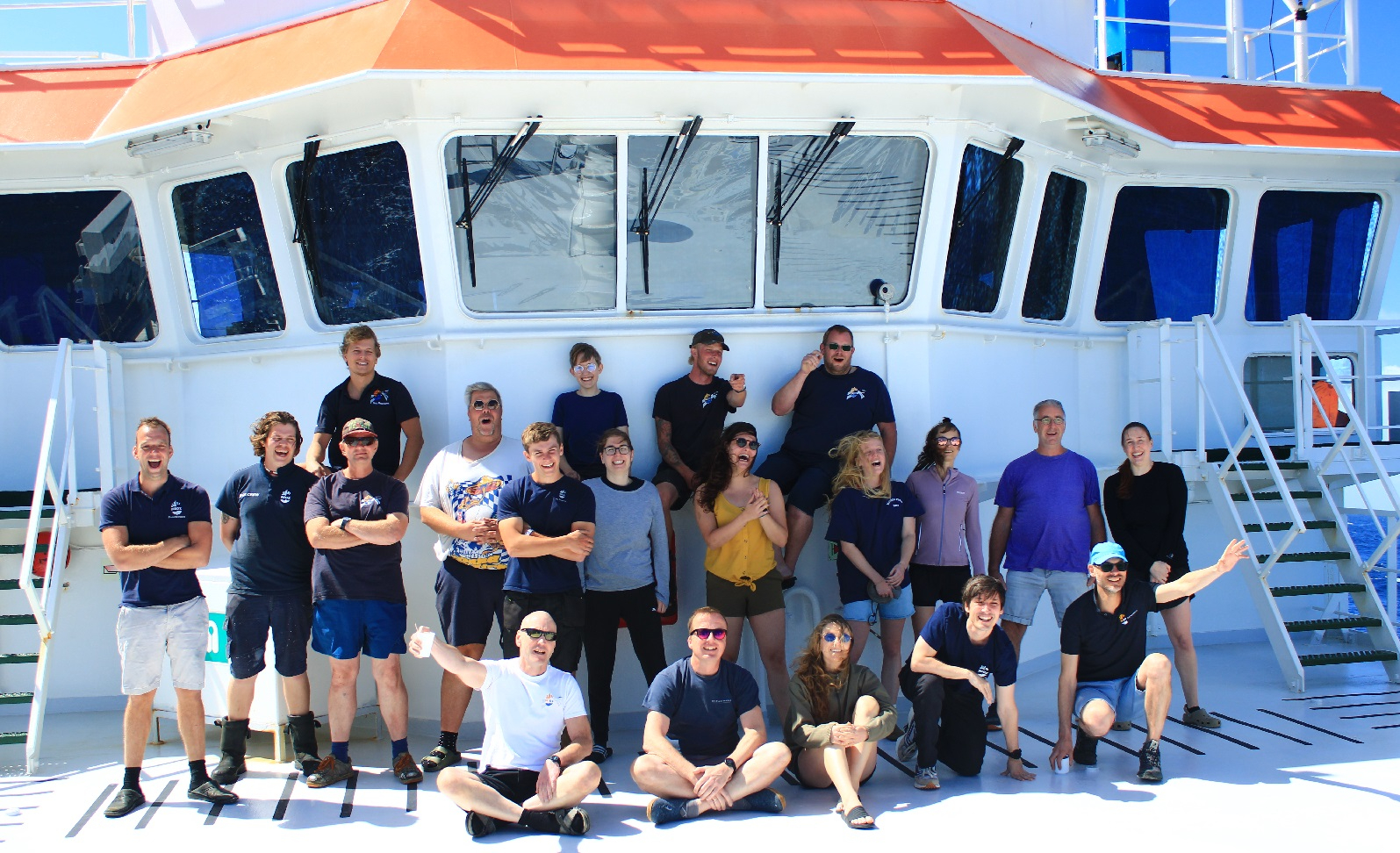
17 February - Tiny little creatures on a rope
Picture a nice day, sunshine and a little breeze. Picture the sea in its deepest blue with the swell gently lifting a ship up and down. This was the day of the mooring deployment for the carbonate mineral dissolution experiment. What are carbonate minerals, you may ask? It’s what the shells of these tiny sea creatures are made of, pteropods (sea butterflies!), foraminifera and coccoliths. When those tiny creatures die, they start to sink to the seafloor and on the way down the shells start dissolving. We are interested in figuring out at what depth and how quickly the dissolution happens. There are lots of these critters in the world’s ocean so this process is quite an important one to understand, especially because it affects how much CO2 the ocean can take up and store.
So, on this very fine day (the finest of them all this cruise), hours were spent on the back deck, taping sample holders with those tiny shells in them to a long rope. This rope reaches from the seafloor at 4800 m up to 600 m below the surface and every 100 m or so samples were placed. It took five hours but with good tunes and some fun banter with the crew it wasn’t the worst way to spend the morning, even if it meant a late lunch. In three months, we will hopefully pick up the samples again and find out how much the shells dissolved (stay tuned!!). However, the work wasn’t yet done for the day, we also did a CTD (see previous blog post in case you forgot what that is) to get water samples from the entire water column because we want to know how the chemical environment looks like that the samples will enjoy for the next couple of months. By the time we were done with that, the stars were out and we spent a long moment on deck, gazing up at the milky way and feeling like tiny little creatures ourselves.
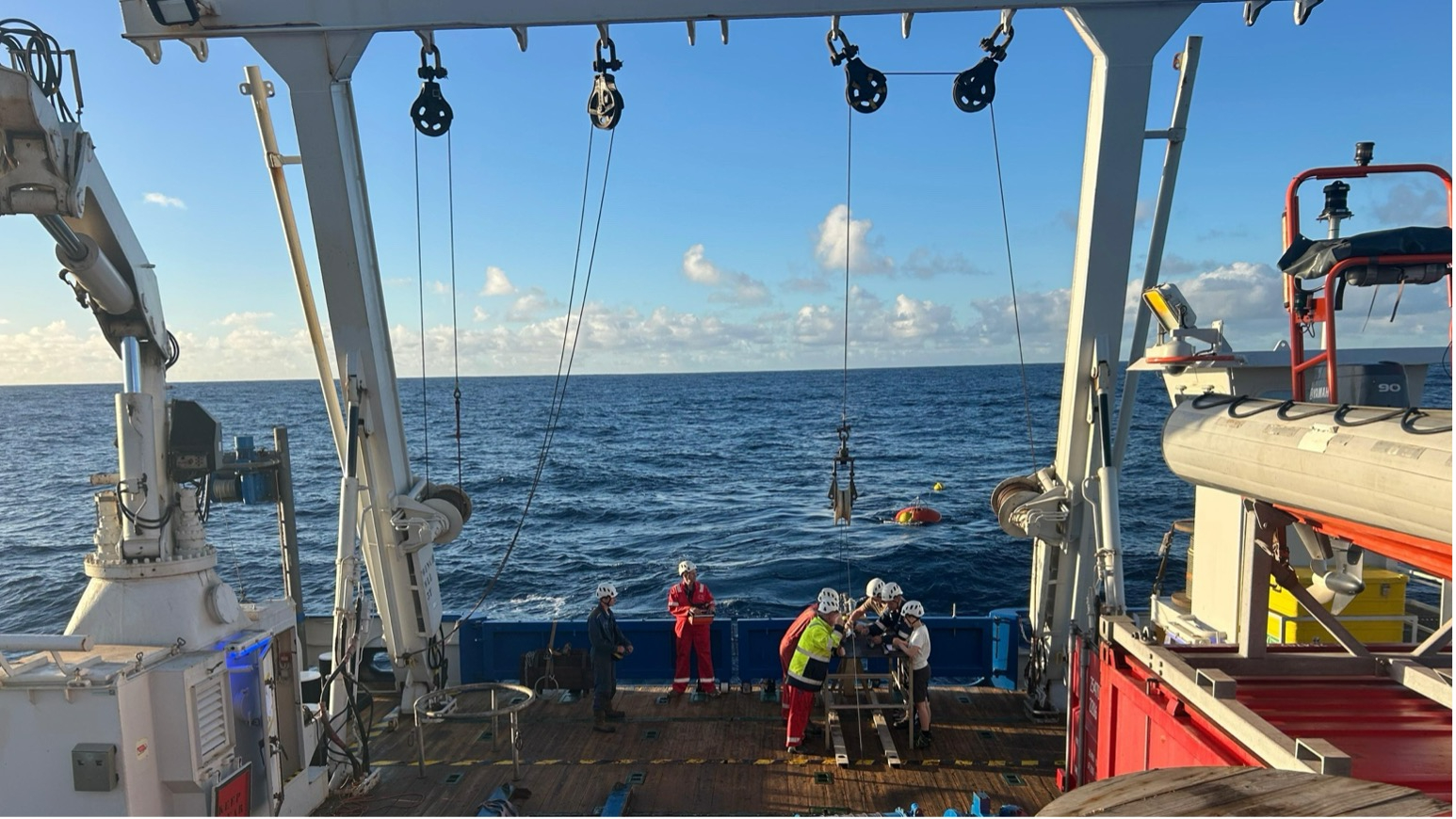
16 February - A ship's belly full of climate archives
About three weeks into the expedition, the end is drawing near. Work is underway at the final station. In the coming days, it will be time to wrap up, finalize the last tasks, and compile the cruise report. Deep in the belly of the ship, most of the sediment cores gathered during the cruise are safely stored—layered with secrets of the past, they hold the imprints of ancient North African climate and its surrounding ocean. Both on board and back home in the lab, these samples will help reconstruct past environments, offering crucial insights into our planet’s functioning. For now, the ship continues its journey, its mission nearly complete, its cargo invaluable.
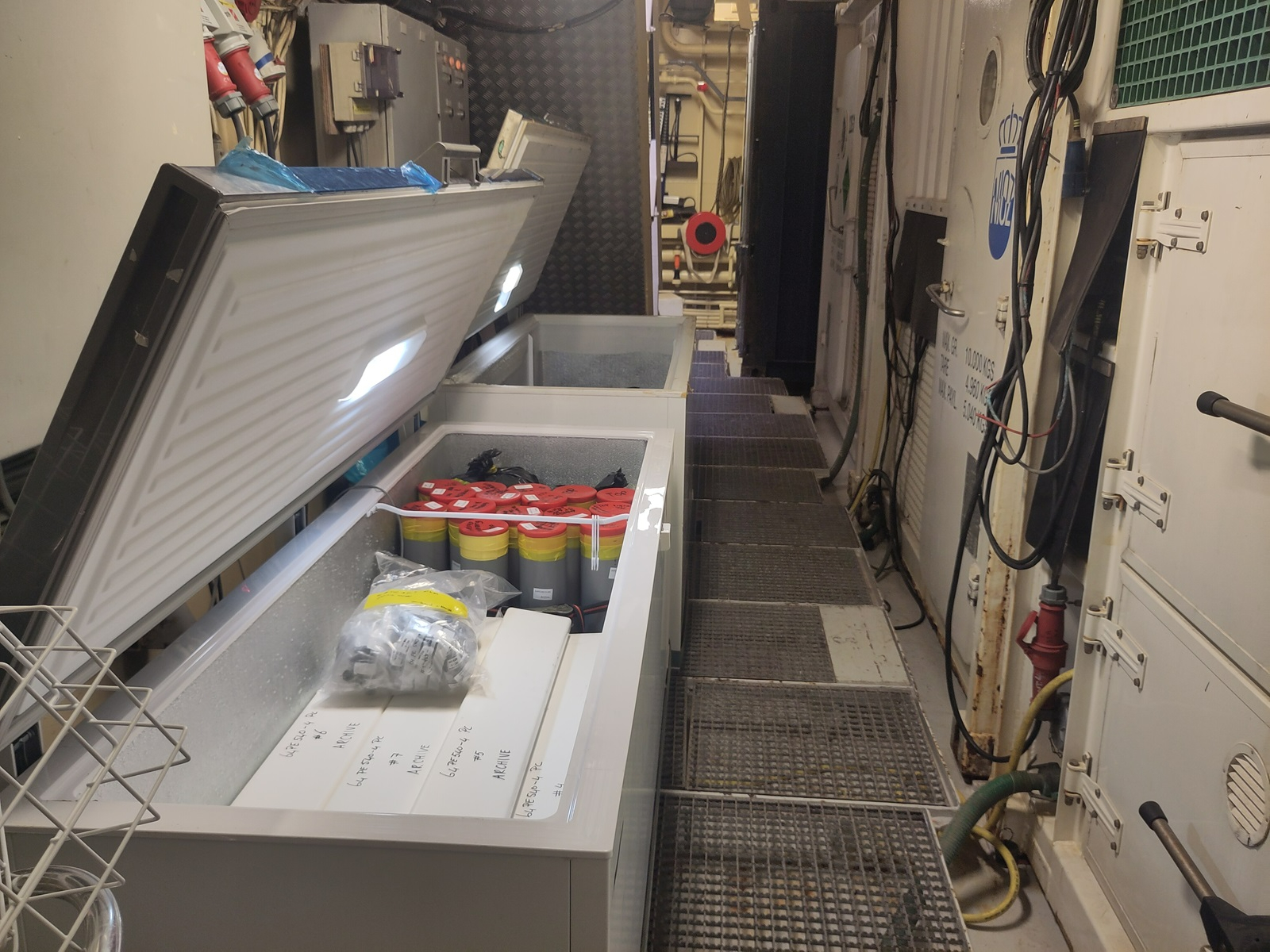
15 February - buoy Carmen
Despite really difficult circumstances ---6-7 Bft wind and a rough ocean thanks to wind-induced waves added to a considerable swell--- master Henk and his crew onboard RV Pelagia managed to recover dust-collecting buoy Carmen.
After a long night of 'harvesting' data and samples from the buoy as well as maintenance, replacement of batteries, and uploading of new sampling schemes, we are now ready to re-deploy the buoy. Carmen will be adding another year to the monitoring time series of not only meteorological conditions but also actual collection of both 'dry' dust (air is being pumped through filters on a carousel) and 'wet' dust (a rain sensor triggers opening of a lid that opens a funnel to fill bottles inside the buoy).
These buoys were designed, built and developed at NIOZ, in close collaboration with colleagues from MARUM-Bremen, and are unique in the world.
Good luck and see you next year Carmen!
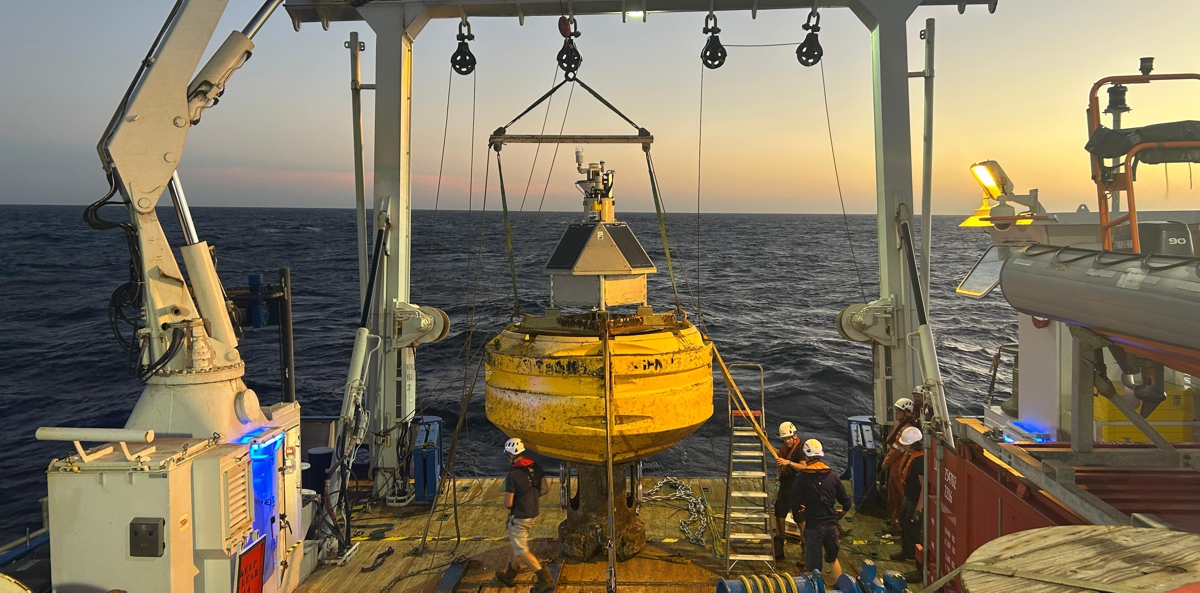
14 February - colourful sediment characterization
The Tip-Top cruise has recovered total of 22.5 m of sediment cores that have all been opened, described and XRF core scanned over the last days. Today the XRF data of the last core has been processed to characterize the main sedimentological changes, compositional variations and the most optimal sampling positions. The compositional characterization based on the XRF scans give a colourful perspective to the Olive Gray sediments including this 8.5 m long taken off Mauretania.

13 February - core subsampling
Loaded up with piston cores, the sampling party continues below deck while the research vessel Pelagia sails with full speed towards the next location further North.
The samples, now little scoops of mud, entail important information, that once back at the NIOZ, will be uncovered through different analyses. Not just some old dust on the shelf, but dating thousands of years back in time, these samples are archives of past climates.
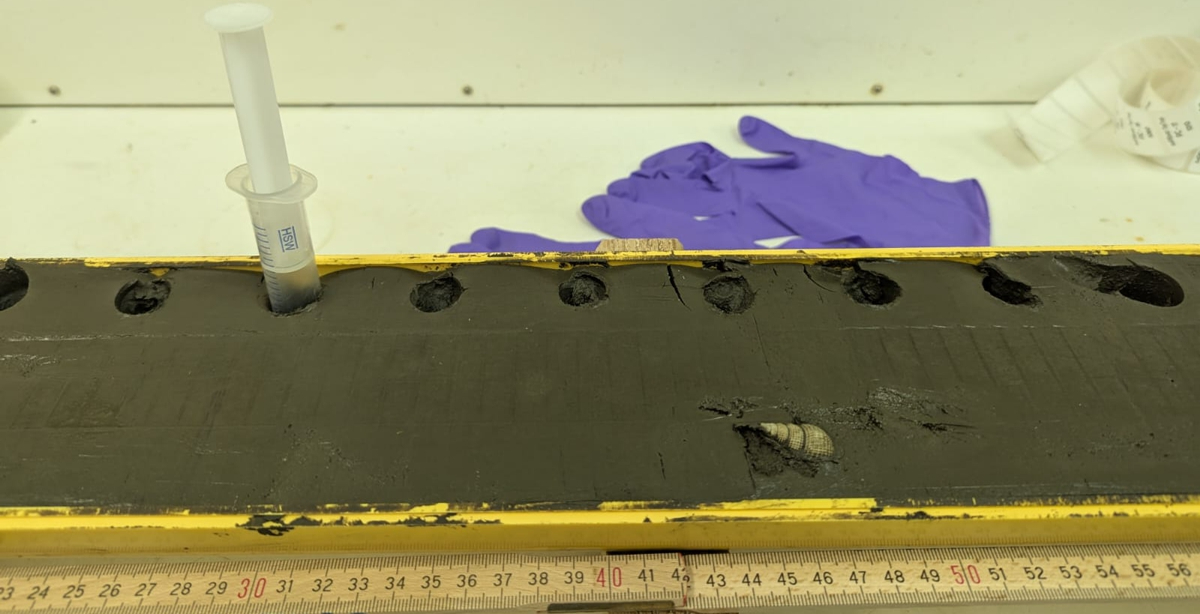
12 February - drifting traps
To get an idea what types of sediments (including surface-ocean plankton) are settling through the ocean, we sample the water column with so-called drifting traps: four tubes suspended at three different depths: 100m, 200m and 400m. These tubes are filled with filtered seawater that has been densified a tick (we added salt) so as to not let the water flow out from the tubes.
With all the dust blowing through the atmosphere lately, we anticipate to find some wind-blown material back in the tubes. Also, we hope to see the potential response of different plankton types to this dust. The drifting traps float freely and we aim to recover them after 24 hours. Fingers crossed for some nice results!
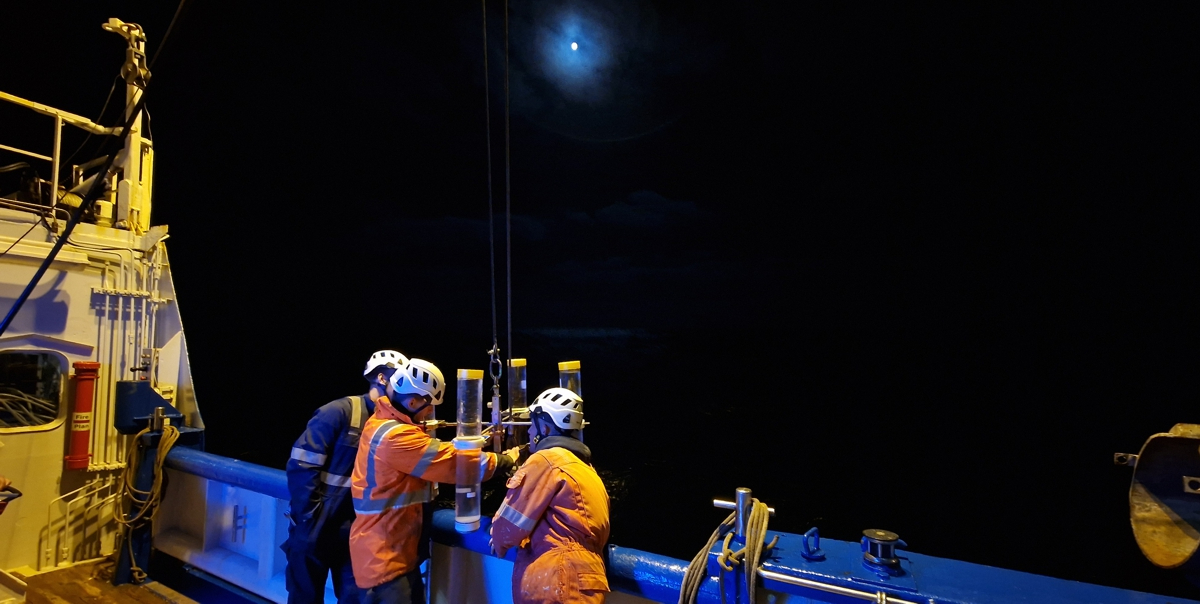
11 February - core not on deck....
“Huh…okay,” were the words uttered by the ever-hardworking Chief scientist Rick Hennekam after the cable devastatingly snapped holding Tip Top voyage’s last piston core. With a brave face, he ran a hand through his salt-sprayed hair and gave thanks to the crew for their efforts in the collection of the previous three cores, “Well, at least this didn’t happen with the first one,” Rick concluded relieved. Studying earth science continuously teeters on a careful balance of destruction and development. Today, the ocean took back a piece of itself, owed by the many cores of sediment we now have packed away in the hull of our ship. This momentous—and, likely, very expensive— occasion did nothing to tarnish the data collected thus far, which is sufficient for the bulk analysis of all our working projects. As dusk closes in on another productive day aboard the RV Pelagia we will journey anew, optimistic for our future scientific endeavors.
10 February - Multicore on deck!
This Superbowl Sunday, the Philadelphia Eagles were not the only ones soaring to victory, as our team collected yet another multi-core sample at station 11. After descending 2200 m, the multi-core sampler was placed on deck for our sediment-focused crew to disassemble. To begin, each tube needs to be unlocked from its holding cage, then plugged with stoppers to preserve the core. After all cores are removed for sampling, four cores are taken to a climate-controlled container with a quadruple core slicing device. The remaining cores are cleaned, labeled, and stored for later processing. For healthy competition, we tested our skills for the fastest multi-core disassembling time coming in just under 4 minutes, about 90 seconds shy of the all-time record. Stay tuned for another record-breaking attempt soon!
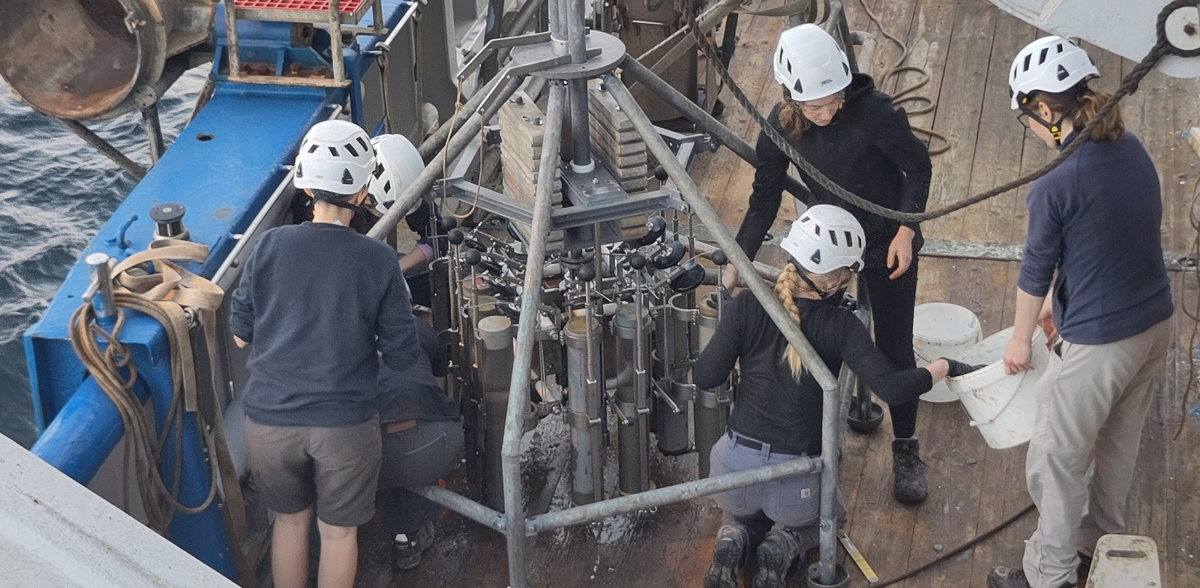
Sampling party
After the multi cores are taken we want to sample them as fast as possible. With two teams of two people we process four cores simultaneously using a quadruple core slicing device, in a climate controlled room. With our team of four we are a sample slicing machine. Gloves on, jams pumping, we sample the cores swiftly as there seems to be a never ending flow of cores coming in. The temperature in the sampling container is set close to bottom water temperature, which can be quite chilly, but that does not get our spirits down. The samples are sliced, bagged, labeled and then frozen until further processing. Onto the next cores it is.
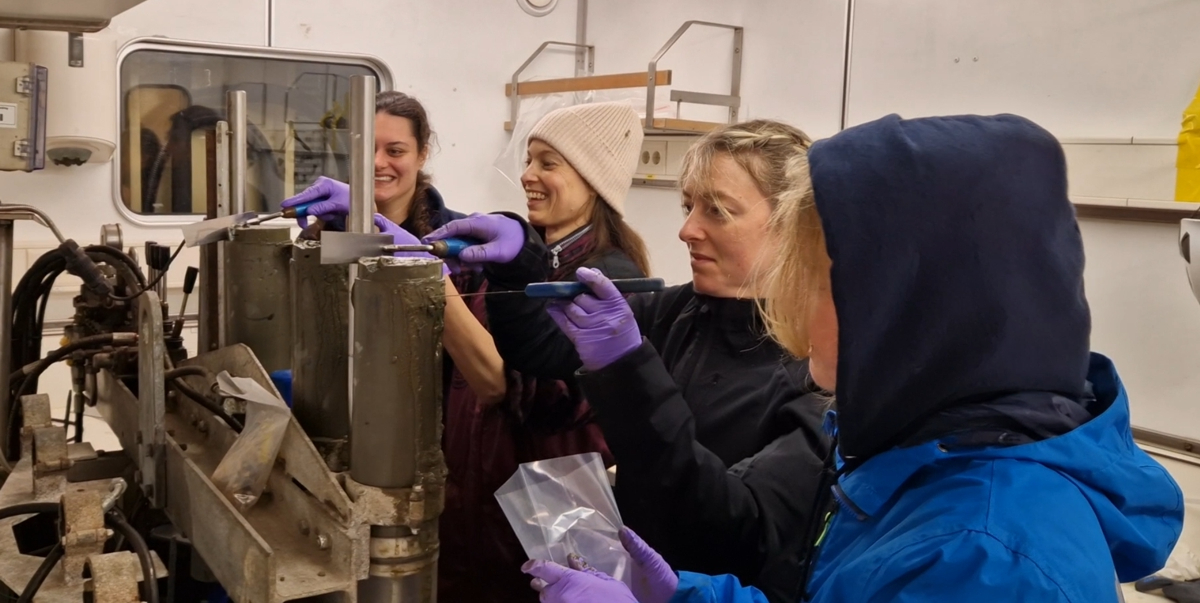
9 February - Just another dusty day at sea
For days now, we are sailing through a major dust outbreak that travels from the northwest African continent across the Atlantic Ocean. The late northern-hemisphere winter is known for large amounts of dust carried westward with the Trades. In this short movie clip one can clearly see how the atmosphere is hazy and how RV Pelagia is covered in a thin layer of orange dust.
8 February – water sampling
Next to the wind-blown dust that is around plenty these days, there is another way in which sediments are transported from the northwest African continent to the Atlantic Ocean: rivers. The northernmost perennial (flowing all-year-round) river that delivers huge amounts of fine-grained sediments to the Atlantic is the Senegal River. Using state-of-the-art organic geochemical tools (so-called biomarkers) we try to understand which organic molecules are typical for these fluvial sediments and how they can be used to reconstruct river run-off through geologic history. To this end, we sample the water at different depths using the CTD; a carrousel-like construction with N=24 bottles with which we can sample at different depths. Once the CTD is back on deck, we pour the water into little vials to be studied in the lab at home. In addition, at some specific depths where we expect concentrations of river material, we want to sample larger volumes of water, which is typically done with in-situ pumps. These autonomous filtration units are lowered into the ocean where they filter for one hour. This way, more than 300 liters can be filtered automatically!
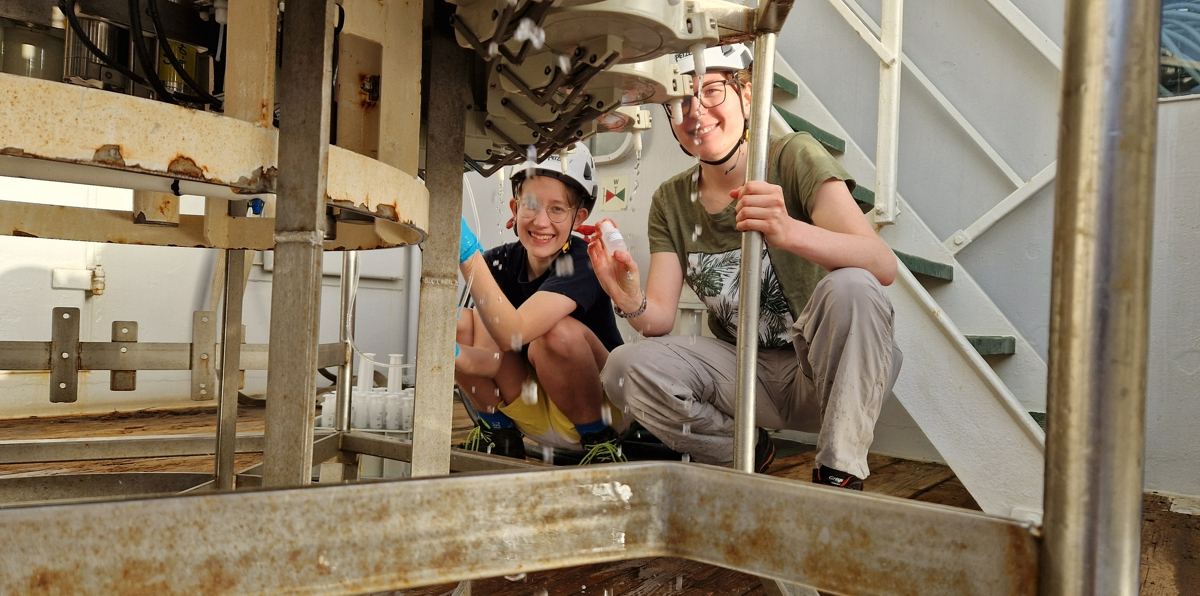
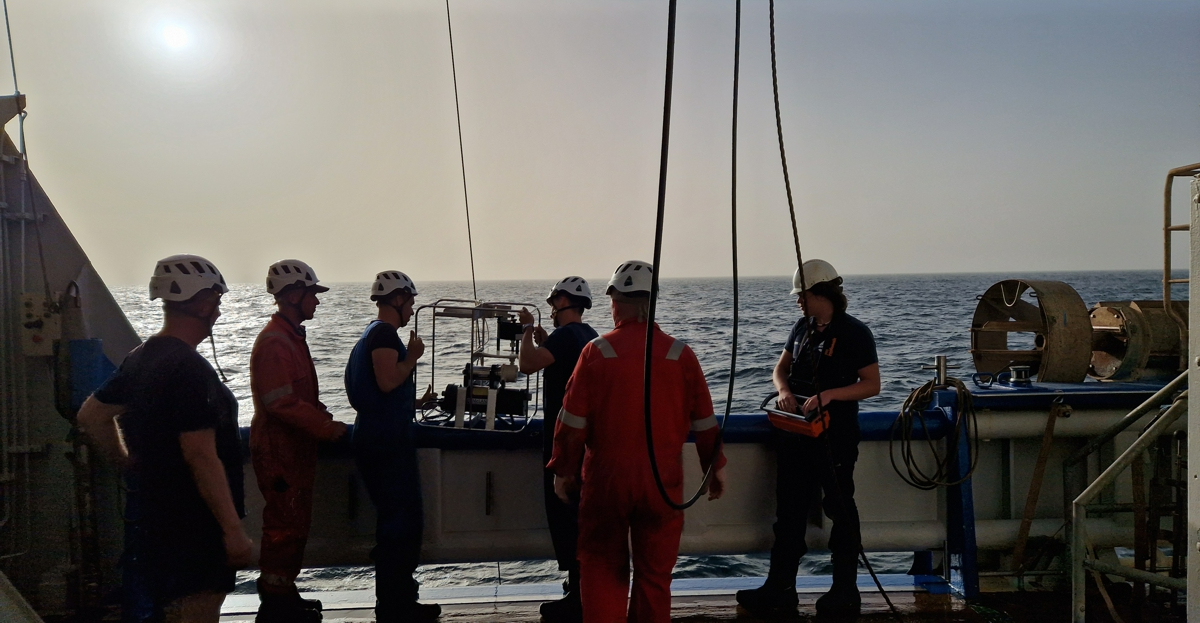
7 February 2025 – all hands on deck!
Today is a very busy day; we will try to visit two stations to sample both the water column and the sediment stack that has deposited on the seafloor through time. Since we are relatively close to the Mauritanian coast, sedimentation rates are very high (in the order of few centimeters per year) so that short-term climate changes in the past are potentially recorded.
During the night, the captain and his team of officers on the bridge have been mapping the seafloor at using a so-called sub-bottom profiler. This way, we can select the best spot to core the upper few tens of meters of sediment with a piston corer. Obviously, we would like to have a core of maximum length, for which we need enough weight on the core to push it into the sediment like a dart. However, putting too much weight on the core could cause it to over-penetrate, or –if it hits a hard layer in the sediment stack—cause the long metal tube to bend, resulting in a banana.
The skilled NMF technicians do a great job, together with the bosun and his deck crew; we manage to recover a 8.5m long record of sediments! In the next few days we will open this core and do some initial measurements using the XRF core scanner. Stay tuned!
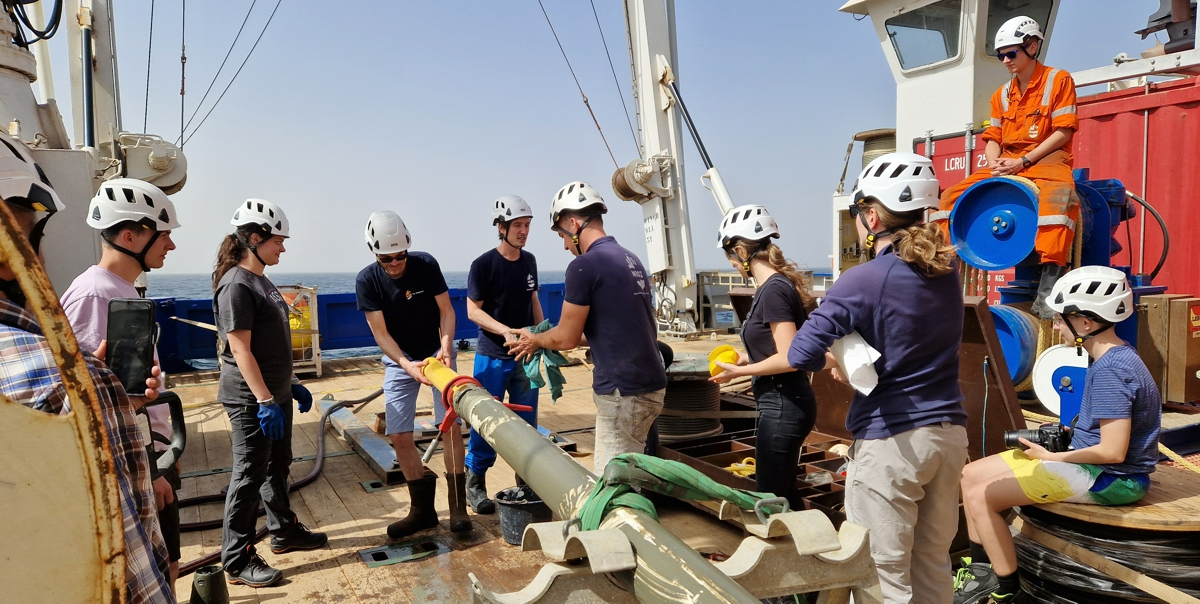
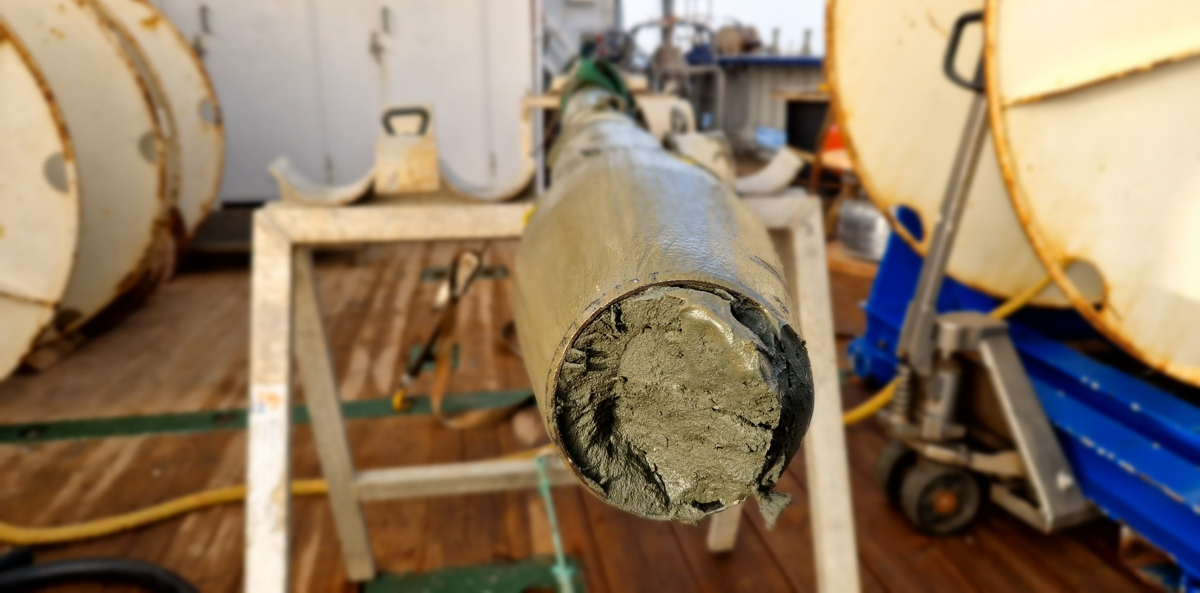
6 February - dusty Nouakchott
We have permission to work on the Mauritanian continental shelf, and a keen observer would like to come and learn from us. Today we will pick up this observer from the harbour of Mauritania's capital: Nouakchott. As one can see in this video, just another dust outbreak causes the air to turn nicely (at least for some!) hazy.
5 February - dust all around
We clearly are in the dustiest part of the Atlantic Ocean; every morning it takes a few minutes extra before we can see the sun because it needs to pierce through a dust layer after having risen above the horizon. Every evening, the sun is already gone before it is even near the horizon due to the thick layer of dust hanging suspended in the lower parts of the atmosphere. It is intruiging to realise that Charles Darwin observed the same haziness above the ocean during his voyage on HMS Beagle in the mid 1800's.
Nowadays, we have satellite observations at our disposal, to see where dust is emitted and where it is blowing to. WIth computer models, we can even make forecasts about where dust will be emitted and where it is transported to. On the basis of observations both on the ground as well as at sea the Copernicus dust model is able to do so and those predictions are visualised by the app Windy.com. By the way, RV Pelagia is one of the many ships that provide meteorological data to this model.
In the YouTube clip below one can see a product of Windy.com; the amount of desert dust that is blowing through the atmosphere. In the lower left corner there is a time bar, showing date and time between 30 January and 6 February 2025 and one can clearly see that we are indeed sailing through a thick layer of dust! The darker brown the colours are, the more dust there is available. Values far exceed the amounts that are advised by the World Health Organisation.... The positions of the two dust-collecting buoys Laura and Carmen, just south and north of the Cabo Verde Islands, respectively, are also indicated.
4 February - a flying-fish story
written by an anonymous flying fish
It is not uncommon to encounter a flying fish amidst the sub-tropical North Atlantic, leaping above the waves. In fact, it would be considered less common to not happen across at least one of these creatures bounding across the warm waves of the Atlantic. Just today, truly no day in particular, one flying fish found herself a character inside this very scene*.
As I broke the surface of the ocean, the first rays of sunlight caught on the spray of water trailing my wake. I flew in the glinting light, letting my wings guide me above a small, cresting wave. I greeted the next wave with a short, simple dive. It was in these moments that I felt most at peace. Although, peace was hardly achievable today as anxiety enveloped my thoughts. I was propelling myself to the annual Feminist fish conference, Fighting Fins for Fins (FFfF), and worried over last year’s agenda yet again not fulfilled. As a board member, I felt personally responsible for our latest defeats. It was with this troublesome worry plaguing my conscience that I just didn’t see it. No encounter with marlin, tuna or predator alike prepared me for the imposing grandeur of the RV Pelagia commandeering any possibility of my escape. So, I flopped and flailed on the hot, prickly surface. I toiled and twisted adjusting to the foreign….land. Land? I know only sea. And now I see—nothing.
Nothing but a great, bright white light belonging to the master’s of the boat. Big booted creatures with smooth fleshy fins plucked me from my peril and set me back to sail into the great wide abyss of my home.
*Based on True Story
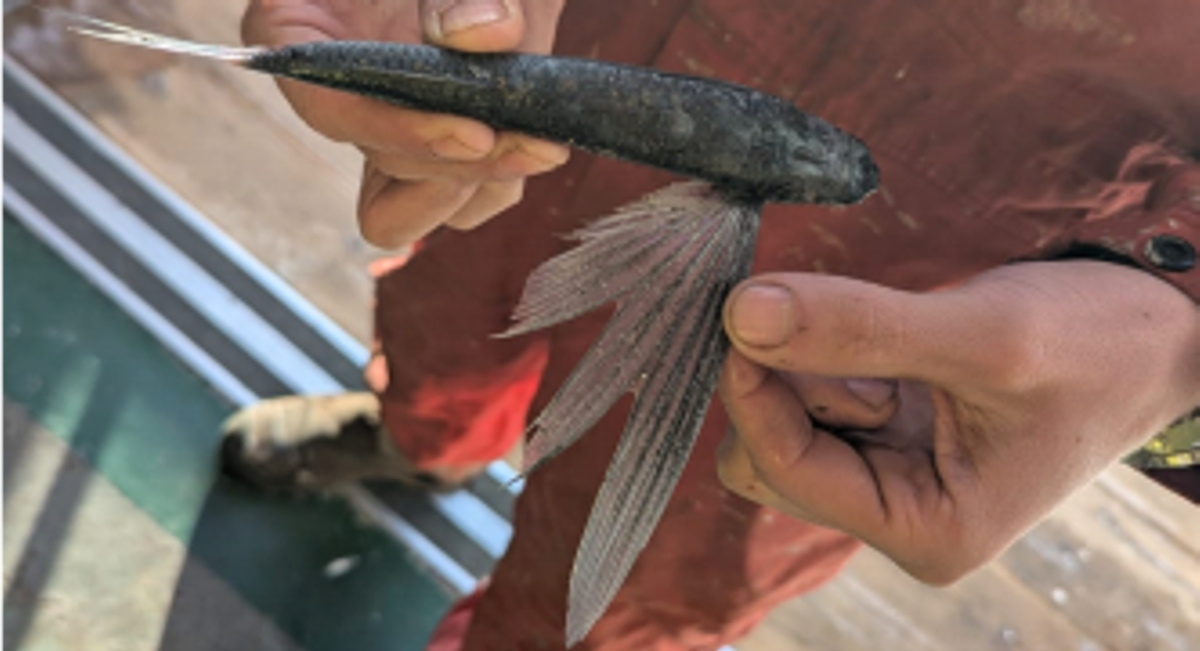
3 February - A dusty master's project
Written by Nienke Badrane
My name is Nienke and this year I joined a research vessel—the Pelagia—under the supervision of Prof. Dr. Jan-Berend. I am in my first year of the Earth Science master’s program at Vrije Universiteit. One of my tasks onboard is helping with daily dust collector operations. My job is to climb to the highest part of the ship to switch the collector’s dust filter every 24 hours. The dust collector works like a vacuum cleaner; a motor sucks air in and the wind sensor ensures the motor only operates when the wind comes from the most optimal directions (north, east, west, relative to the ship). This prevents contamination from the ship’s engine when the wind comes from the south. Once I collect the filter, I replace it with a fresh one, noting the ship’s position, the weather conditions, and status of the device (such as total flow and running time). We will later analyze the dust samples in terms of grain size and chemistry to understand their composition and origin. It’s cool to see how much dust can accumulate on the filter each day. I’m very excited about the results that come out of this experiment! I’m also curious about my future tasks such as analyzing sediment cores, dust buoy samples, and sediment traps!
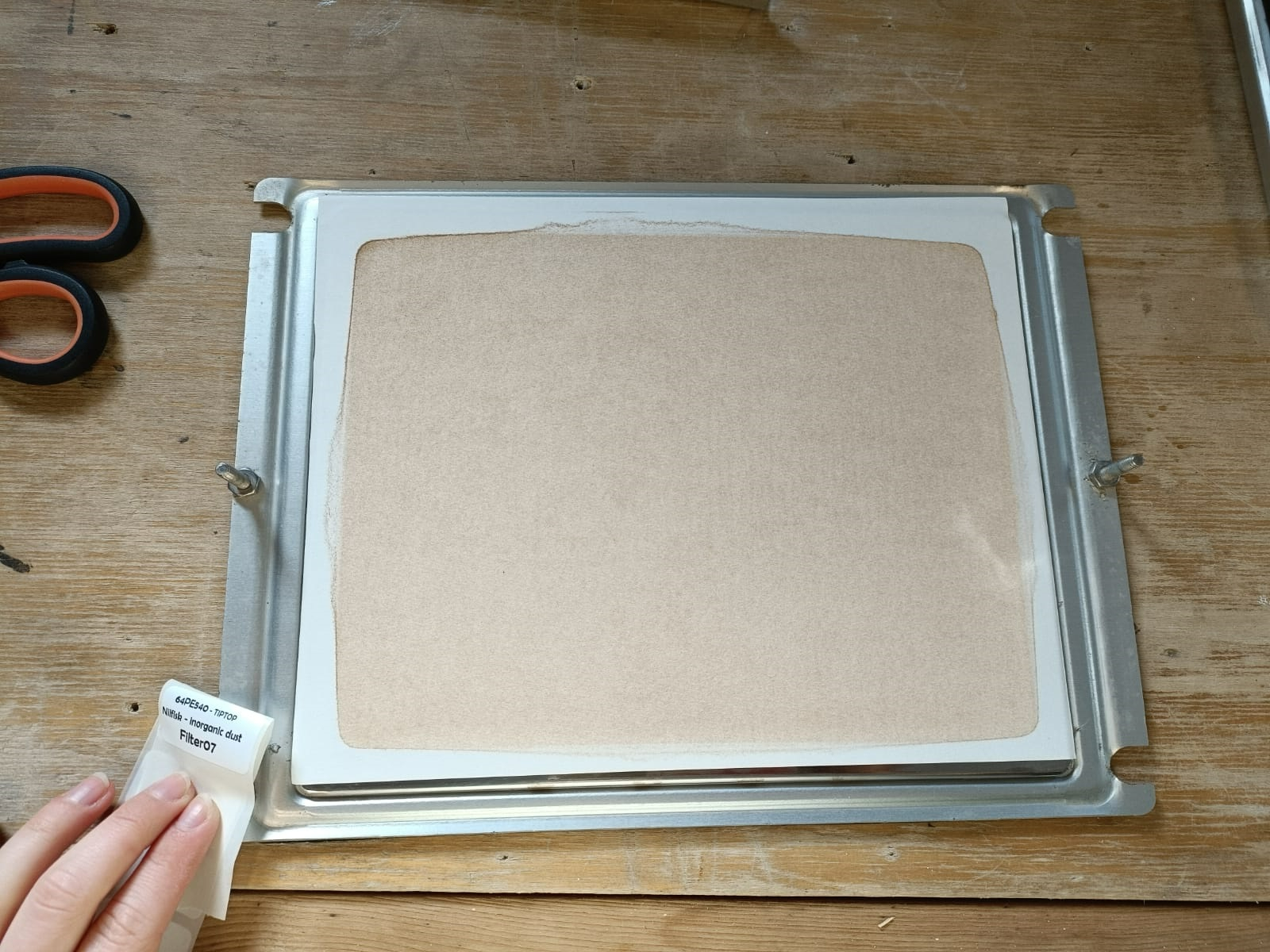
2 February - First water samples
Unfortunately the conditions were quite rough in the morning, so it was too dangerous for the crew to recover the dust-collecting Buoy Laura. However, we could still do a CTD with these conditions, allowing us to take water samples from the water column and measure important parameters in the water column (such as temperature, salinity, and oxygen contents). Below you can see Darci and Ben discussing some conspicuous low values in the oxygen content around 500m depth...Hoping for slightly better wetter the next day, so we can start recovering the moorings at this site!
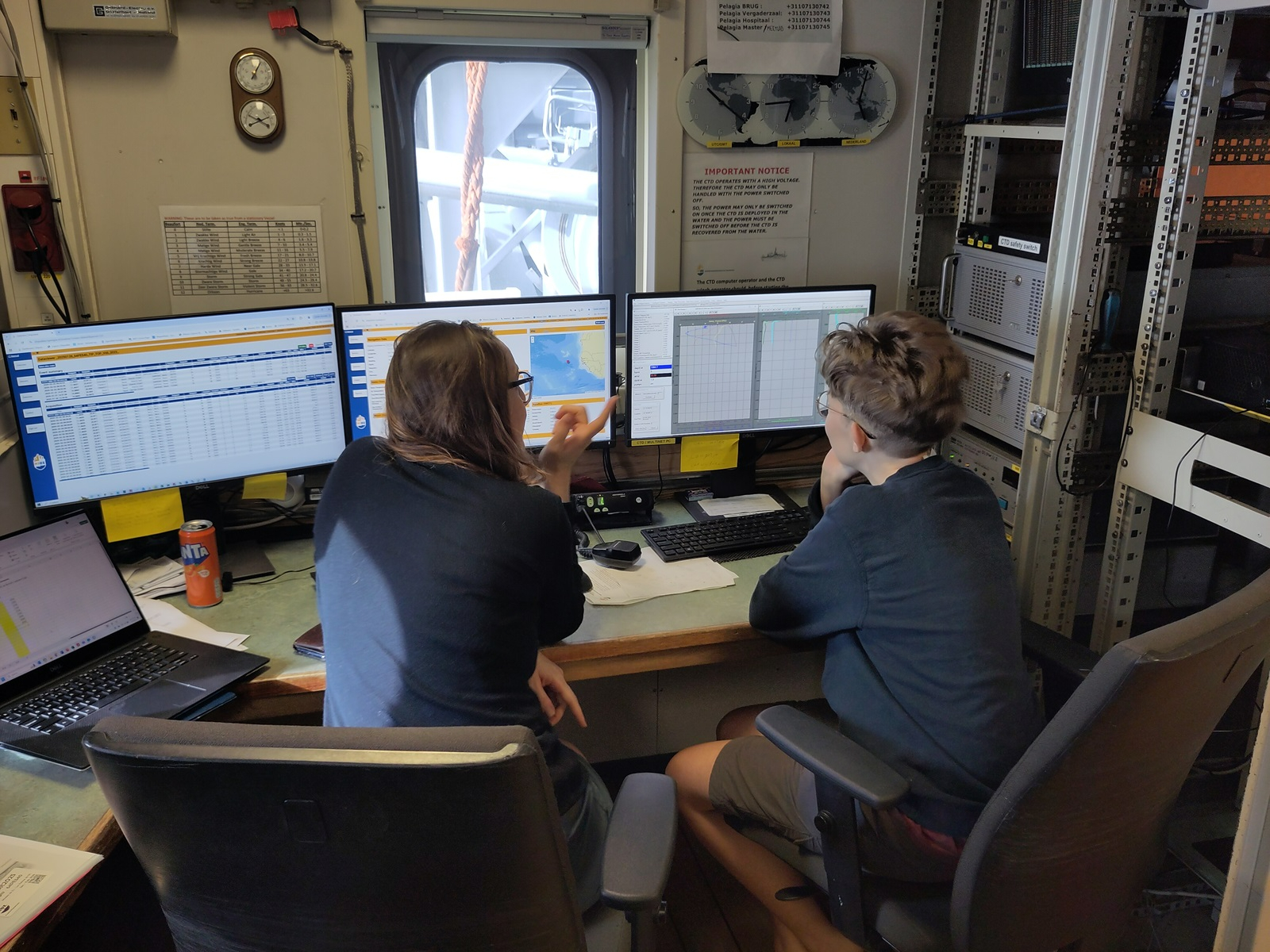
1 February - Getting ready for action
We are well on our way to our first station, just South of Cape Verde. Arrival at our first site is scheduled for tomorrow morning, so everyone is in preparation for arrival there. In the morning we planned a meeting at the bridge to discuss the operations there. First stop: Dust-collecting buoy Laura! Everyone is ready for action.
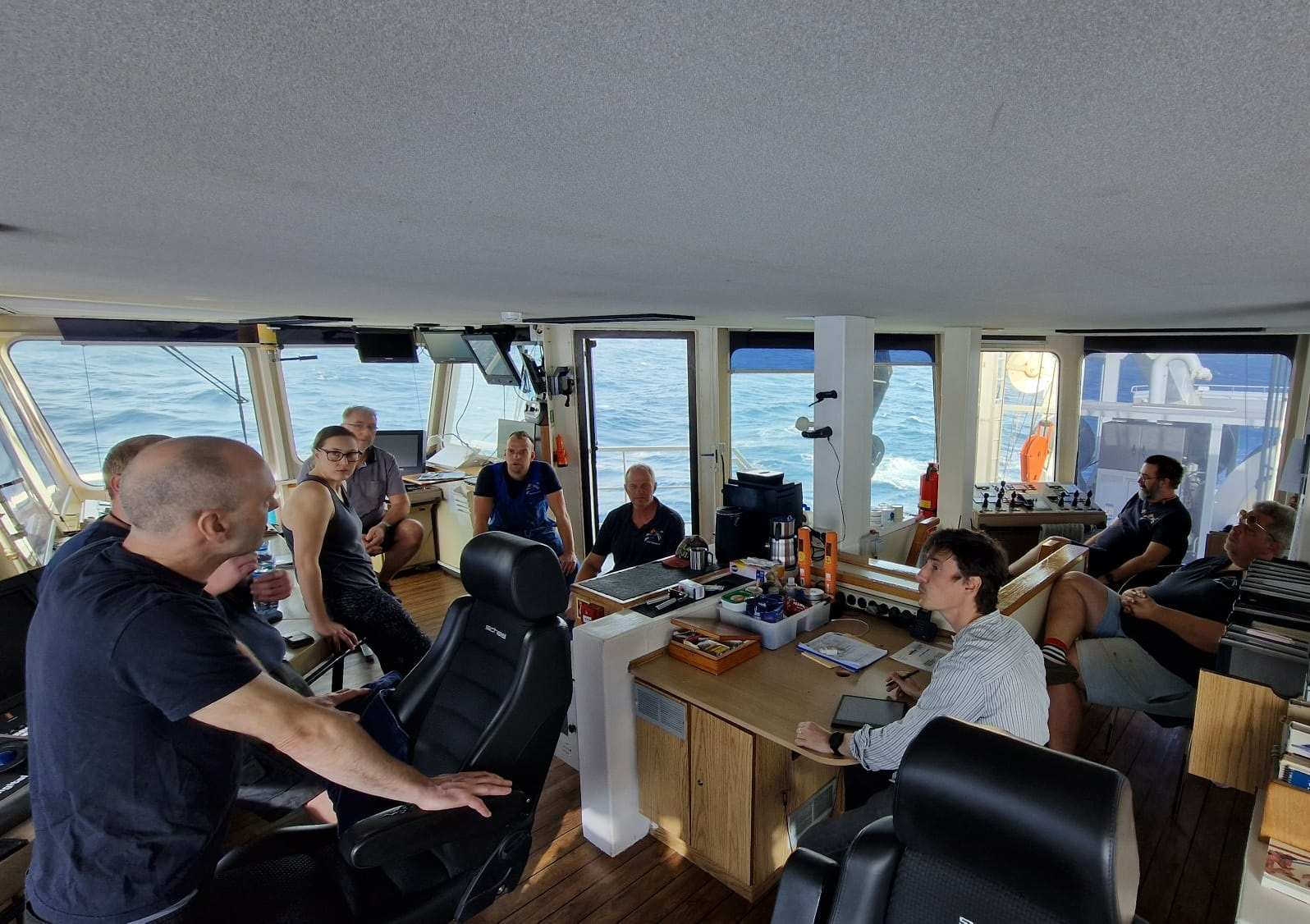
31 January - Start of the expedition!
We needed to wait for fuel a couple of days in the port of Mindelo. On the 31st we got the good news that we were getting fuel that morning and so we left port to our first station in the afternoon! Everybody is in good spirit to start our expedition. The first samples of the cruise are being collected at the top of the bridge with our dust collectors. Lots of dust in the air due to the massive dust cloud from the Sahara that spreads all the way to South America.
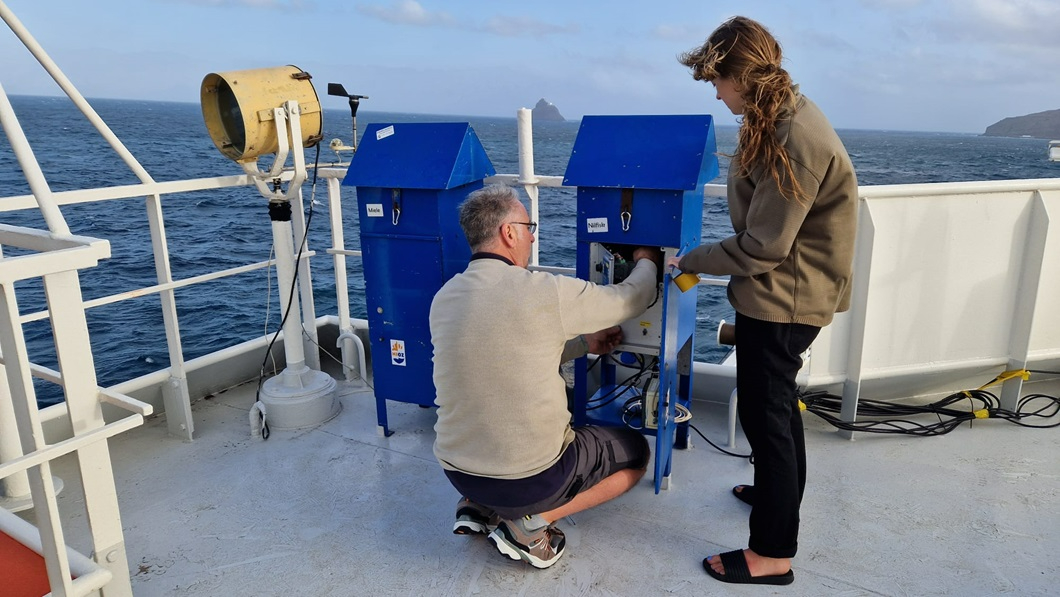
30 January - dust is in the air!
Both the app Windy.com as well as NASA's satellite images confirm it: a big cloud of Saharan dust is presently blowing from the northwest African continent westward and over the Cabo Verde Islands. We do not notice this very clearly, although it seems there is a haze/fog hanging over the water. This is best seen in the image below, where otherwise the island of Sao Tome would be clearly visible, but thanks to the dusty haze, today it is not.....
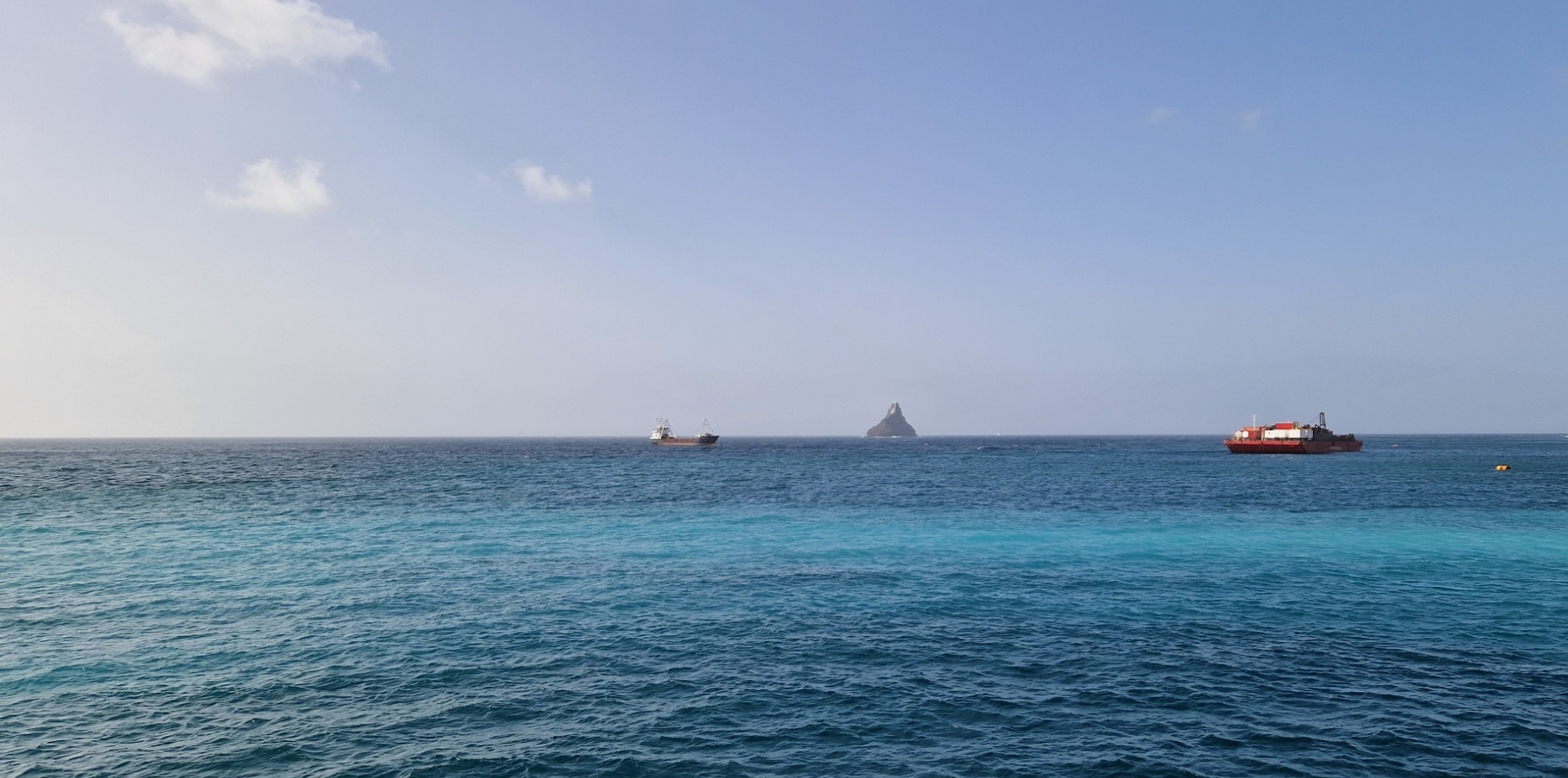
Here one clearly sees how the sun pierces through the clouds and how the sunlight is also filtered through the dusty atmosphere.
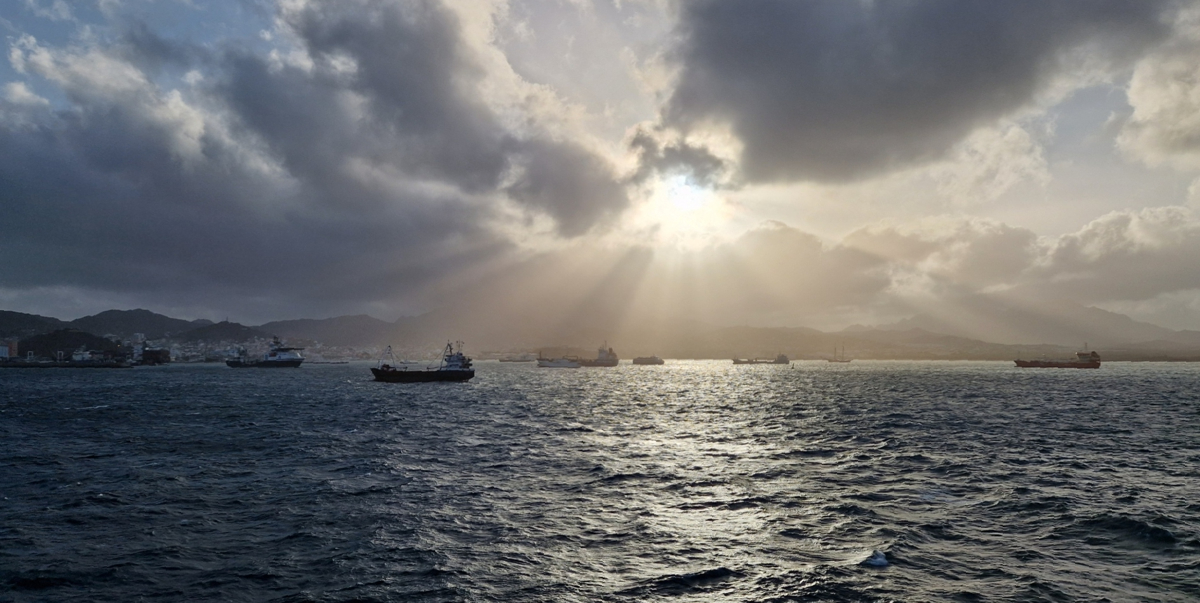
29 January - Safety first
To familiarise ourselves with the ship (again) and to know what to do if something goes wrong on board, we get both an extensive briefing by second officer Ravi as well as a 'real' drill in which the alarm is sounded and we all have to go to the muster station with our life suit and life vest. We hope we will never have to apply the things we learned!
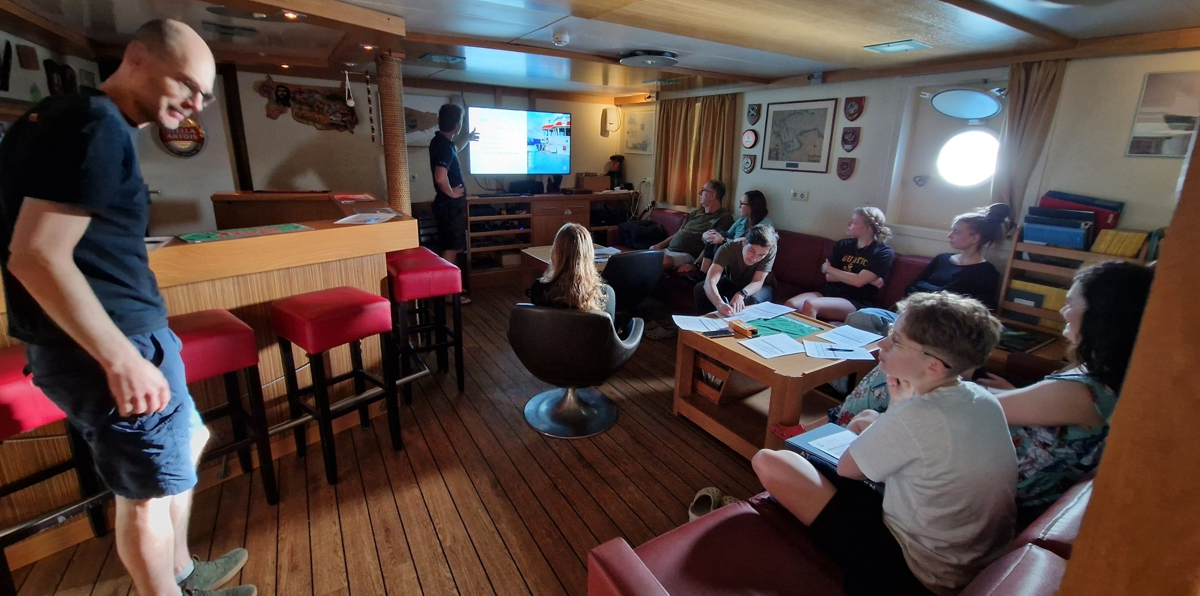
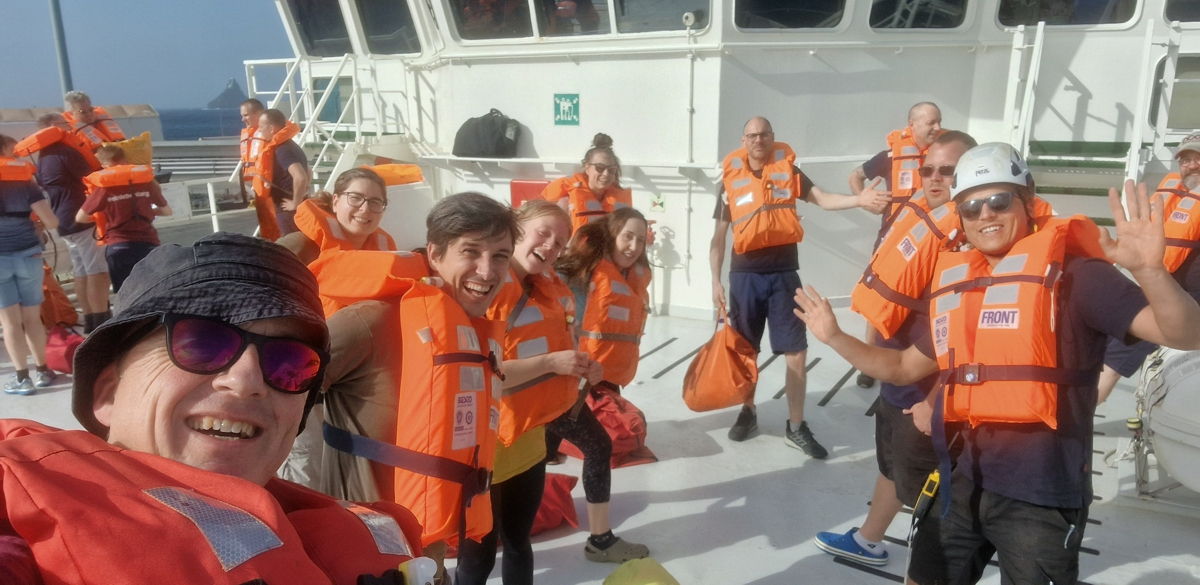
28 January - the TIP-TOP team
In between all the preparations we quickly jump on land for a group picture in front of our home for the next few weeks: meet the TIP-TOP team!
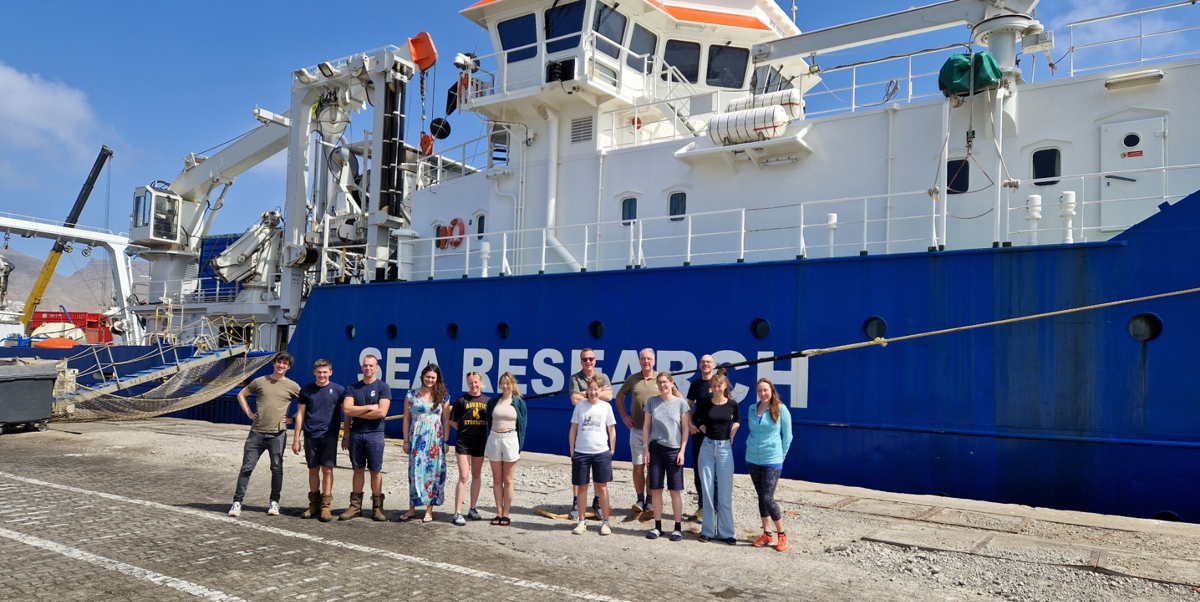
27 January 2025 - arrival at Sao Vicente
Just after midday we arrive at Cesaria Evora airport on Sao Vicente, one of the northern Cabo Verde islands. We are welcomed by a stiff wind, which kicks up quite some (local) dust!
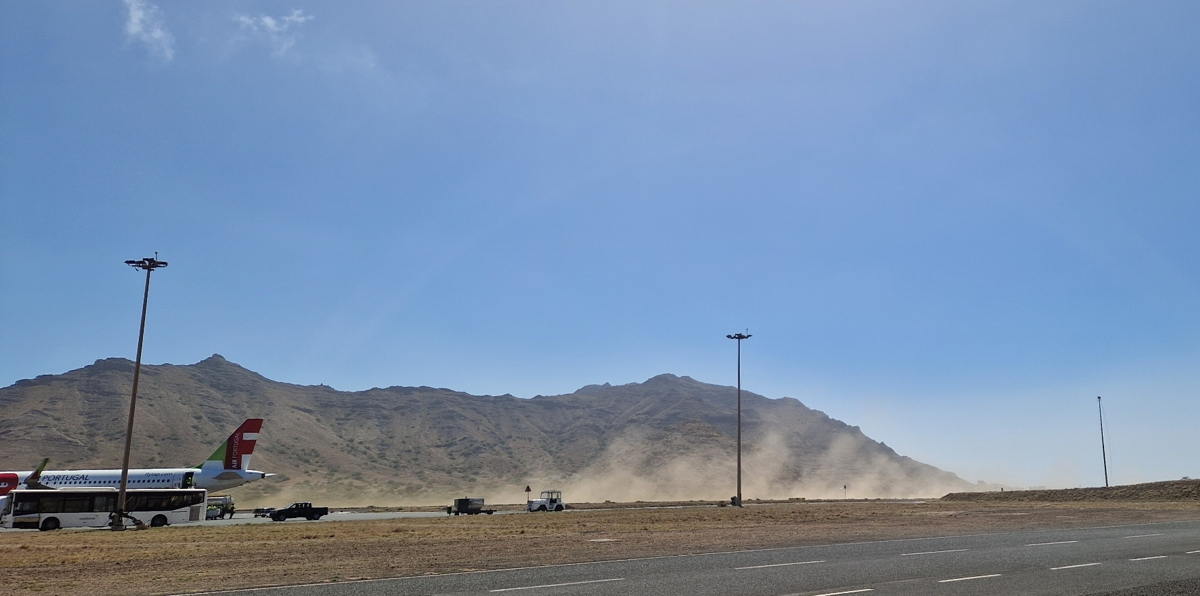
After a swift passage through immigration we are picked up and transported to the harbour where RV Pelagia is waiting for us.
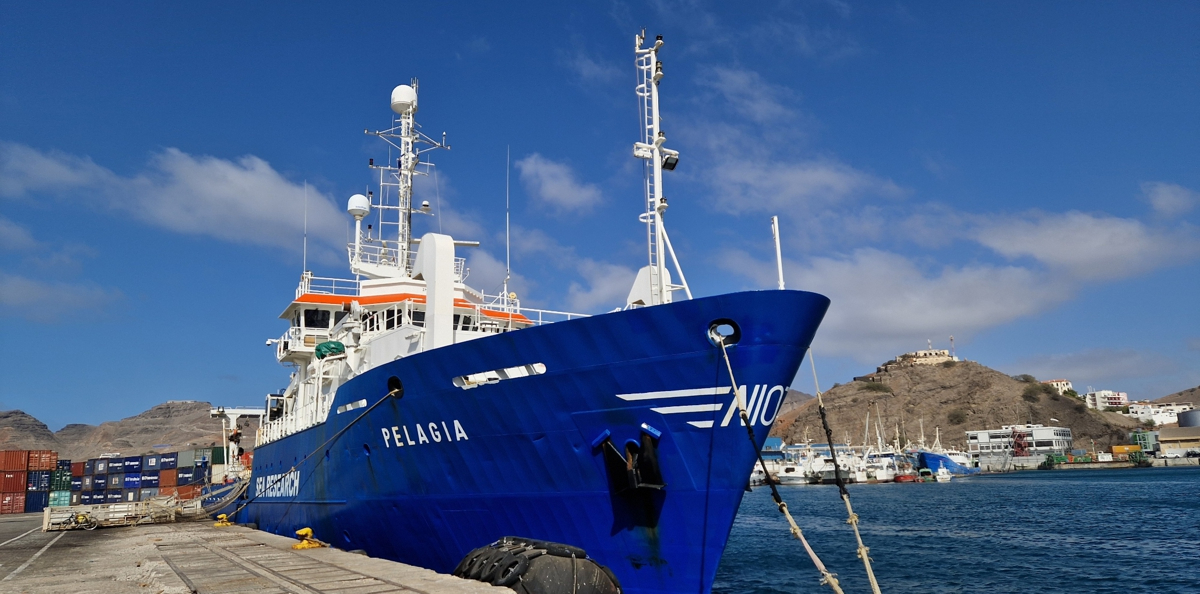
17 January 2025 - clear skies, with some dust
On this satellite image, one can see clear skies along the northwest African coast. A few of the Canary Islands are just visible below thick white clouds at the top of the image. The Cabo Verde Islands are clearly exposed in the lower middle of the image, although a thin North-South oriented dust cloud is also visible.
The image was acquired from NASA's earthobservatory website.
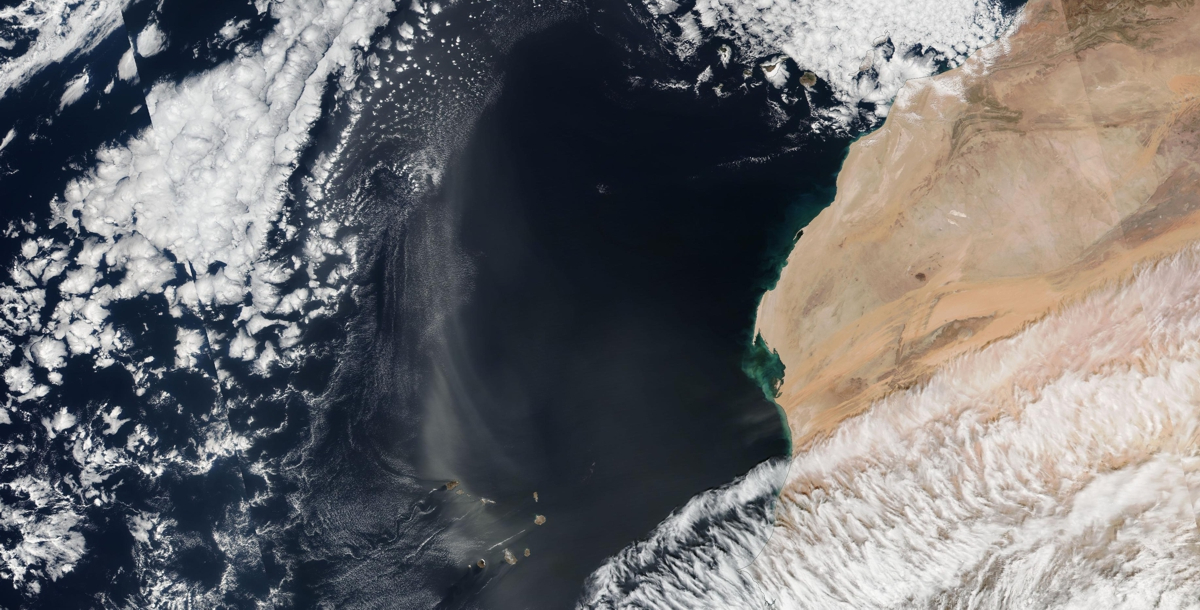
1 November 2024 - cruise preps and packing
Organising an expedition is a lot of work and preparations usually start months before. Here you see NIOZ - NMF technicians Jan-Dirk and Barry (can you spot him?) packing the first set of containers that will be put on board RV Pelagia in the harbour of Cape Town, South Africa. These containers were shipped there already in November 2024.
